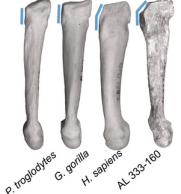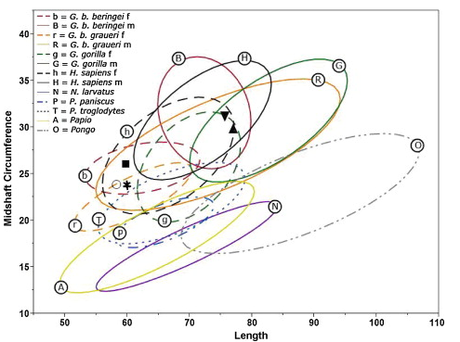Last week the Cleveland Museum of Natural History updated their reconstruction of the 3 million year old possible human ancestor, Lucy. They used recent discoveries of other members of her species (Australopithecus afarensis) to fill in some of the gaps in Lucy’s skeleton (she’s only 43% complete after all). This really annoyed the young earth creationist organisation Answers in Genesis, since the additional finds provided even more evidence that Au. afarensis was bipedal (as if more was needed).
One of AiG’s key arguments for rejecting Lucy as a possible human ancestor is that she was a knuckle walking quadruped, like a chimpanzee, rather than an upright biped like humans. So, to continue making this claim in the face of even more contradictory evidence they made the absurd argument that Big Man (the new skeleton on which the reconstruction was based) was actually human!

The AL 333-160 metatarsal compared to those of apes
However, Big Man was not the only skeleton incorporated into the new Lucy reconstruction. According to AiG a single new foot bone (known as AL 333-160) was also used to help update Lucy. I say “according to AiG” since I haven’t been able to find an external source that says the bone was used in the reconstruction and they don’t provide a citation for the claim. But then I haven’t seen the presentations connected to the new reconstruction, so I’m not going to make a big deal out of the fact.
AL 333-160 is a lone metatarsal which bares many striking similarities to human metatarsals. From this, the discoverers conclude that this bone is evidence that Lucy’s species walked upright along the ground, like modern humans. So, like Big Man, Answers in Genesis also has to argue that this bone is actually human and so doesn’t provide any evidence Lucy walked upright, like us. That way they can keep arguing she moved like a chimp.
But if it looks so human, could it possibly be from a human? Evolutionary anthropologists would say absolutely not, because the volcanic rock in the region is dated at 3.6 million years old, before (they contend) humans evolved
So if it looks so human why do scientists label it as an Australopithecus bone? Well over 370 other bones have been recovered from the same location, all of which were also from Lucy’s species. The researchers also note that many of the “human” characteristics have also been identified in other early hominins, so don’t necessarily mean a bone belongs to our species.
For example, Ardipithecus ramidus (a possible human ancestor that lived 4.4 million years ago, over a million years before Lucy) also has a domed metatarsal like AL 333-1601. So either these features don’t necessarily mean you have a human on your hands or Answers in Genesis will have to start arguing that “Ardi” is actually human as well.
But these reasons are not good enough for AiG, who ask:
How do we really know that all the miscellaneous fossils in this strata are afarensis bones? After all, if an intact human skeleton were to be found fossilized in this rock, evolutionists would classify it as anything but human because they have already decided that a human could not have existed at the time they contend the rock was laid down.
Those foolish evolutionists are so blinded by their assumptions that they wouldn’t recognize a complete human skeleton if they found it!
Stripped of such unverifiable assumptions, the case for building a brand new look for Lucy on the basis of a single isolated human-looking bone that evolutionary scientists chose to “assign” to Australopithecus afarensis seems quite a stretch
So, the only reason to accept AL 333-160 as Australopithecine is because of unverifiable evolutionary assumptions about radiometric dating and hominin evolution. Stripped of those, it’s obvious that this bone is actually human and those evolutionists are fools for not realising it!
Well, it turns out that there is a problem with the original research into the metatarsal. But it isn’t that the bone is fully human. Quite the opposite in fact.
The original investigation only compared AL 333-160 to 30 members of 3/5 ape species. When this sample size is increased to include a more diverse selection of modern apes it is revealed that AL 333-160 (and modern human metatarsals) fall within the range of modern gorilla feet2. So if you follow AiG’s logic, gorillas have human feet and it’s only your evolutionary assumptions that stop you realising this obvious fact!

A chart depicting the range of variation in ape metatarsals. The star represents AL 333-160, the other symbols represent other fossil hominin feet
It’s often said that the conclusion is the point at which you stop thinking and I think AiG’s article is a great example of that. They clearly have their own assumptions about what the fossil record should contain (only full humans or full apes) and once they decided AL 333-160 was fully human the case was closed. As a result their academic integrity is severely compromised; since they didn’t bother reading critical papers about the bone because they already had the answer they wanted.
The key information they missed out on not only has absurd implications for their argument, but thoroughly invalidates the idea that AL 333-160 is a modern human. It’s also delightfully ironic that whilst they criticize evolutionary “assumptions” their own have stopped them properly researching the topic, with hilarious consequences.
References
- Ward, C. V., Kimbel, W. H., & Johanson, D. C. (2011). Complete fourth metatarsal and arches in the foot of Australopithecus afarensis. Science,331(6018), 750-753.
- Mitchell, P. J., Sarmiento, E. E., & Meldrum, D. J. (2012). The AL 333-160 fourth metatarsal from Hadar compared to that of humans, great apes, baboons and proboscis monkeys: Non-conclusive evidence for pedal arches or obligate bipedality in Hadar hominins. HOMO-Journal of Comparative Human Biology.
Hat tip to Ashley, for pointing out this research to me.

